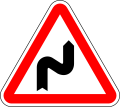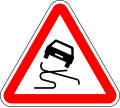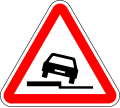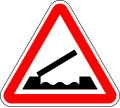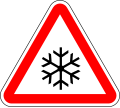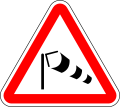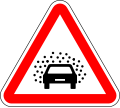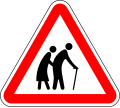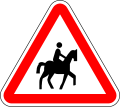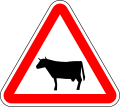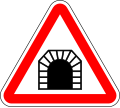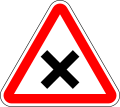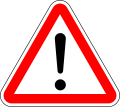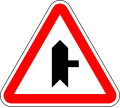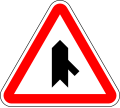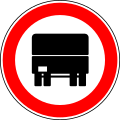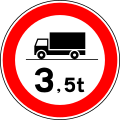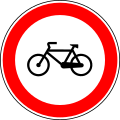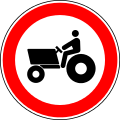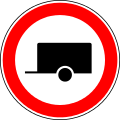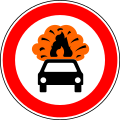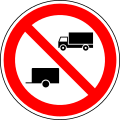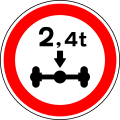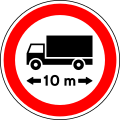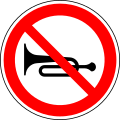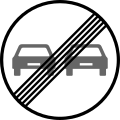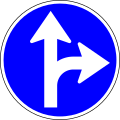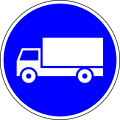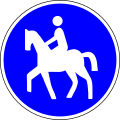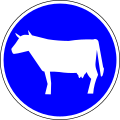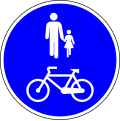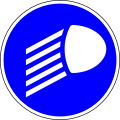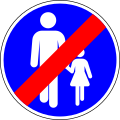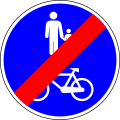Road signs in Portugal: Difference between revisions
Nferrara100 (talk | contribs) m Missspelled English word |
Nferrara100 (talk | contribs) m Grammar |
||
| Line 76: | Line 76: | ||
<gallery> |
<gallery> |
||
File:Portugal road sign C1.svg|No entry |
File:Portugal road sign C1.svg|No entry |
||
File:Portugal road sign C2.svg| |
File:Portugal road sign C2.svg|No vehicles both directions |
||
File:Portugal road sign C3a.svg|No motor vehicles |
File:Portugal road sign C3a.svg|No motor vehicles |
||
File:Portugal road sign C3b.svg|No dangerous good |
File:Portugal road sign C3b.svg|No dangerous good |
||
Revision as of 11:14, 4 December 2023
This article relies largely or entirely on a single source. (May 2022) |

Road signs in Portugal are governed by the "Regulamento de Sinalização do Trânsito[1]" (Road Signage Regulation) of the Republic of Portugal.
They are installed along the road on the right side of the road and are subdivided into warning signs (group A), regulatory signs (groups B-D), subdivided into priority, prohibition, obligation and specific prescription signs, indication signs (groups H-T), subdivided into information signs, pre-signalling, direction, confirmation, location identification, supplementary signs, additional signs and temporary signs (groups AT and TC).
The typeface used on road signs is Transport Heavy (the same as used in Italy). Portugal is an original signatory to the Vienna Convention on Road Signs and Signals.[2]
Warning signs
-
Dangerous curve to right
-
Dangerous curve to left
-
Double curve, first to right
-
Double curve, first to left
-
Bump
-
Dip
-
Uneven road
-
Steep hill downwards
-
Steep hill upwards
-
Road narrows on both side
-
Road narrows on left
-
Road narrows on right
-
Slippery road
-
Loose chippings
-
Dangerous shoulder on right
-
Dangerous shoulder on left
-
Unprotected quayside or riverbank ahead
-
Falling rocks
-
Opening or swing bridge
-
Ice or snow
-
Sidewinds
-
Reduce visibility
-
Children
-
Elderly people crossing
-
Pedestrian crossing
-
Pedestrians
-
Cyclists
-
Equestrians
-
Domestic livestock
-
Wild animals
-
Tunnel
-
Low-flying aircraft
-
Traffic signals ahead
-
Roadworks
-
Crossroad without priority
-
Two-way traffic
-
Level crossing with gates or barriers
-
Level crossing without gates or barriers
-
Tramway
-
Other dangers
-
Traffic queues likely
-
Accident
-
Blind spot
-
Farm machinery
Priority signs
-
Priority road
-
End of priority road
-
Priority for oncoming traffic
-
Priority over oncoming traffic
-
Roundabout ahead
-
Crossroad with priority
-
Side road with priority on left
-
Side road with priority on right
-
Merging traffic on left
-
Merging traffic on right
Prohibition signs
-
No entry
-
No vehicles both directions
-
No motor vehicles
-
No dangerous good
-
No lorries
-
No lorries over 3.5 tonnes
-
No motorcycles or mopeds
-
No mopeds
-
No cycles or mopeds
-
No agricultural vehicles
-
No animal-drawn vehicles
-
No hand-carts
-
No pedestrians
-
No equestrians
-
No trailers
-
No trailers over 2 tons
-
No vehicles carrying dangerous goods
-
No vehicles carrying explosives
-
No vehicles carrying polluted water
-
No buses
-
No motor vehicles
-
No lorries and trailers
-
No motor vehicles and animal-drawn vehicles
-
No trucks and animal-drawn vehicles
-
No pedestrians, mopeds, animals, and handcarts
-
No bicycles, mopeds, and motorcycles
-
No trucks and buses
-
Axle limit
-
Weight limit
-
Length limit
-
Width limit
-
Height limit
-
Driving vehicles distance
-
No right turn
-
No left turn
-
No U-turn
-
Maximum speed limit
-
No overtaking
-
No overtaking by lorries
-
No overtaking by motorcycles
-
No parking
-
No standing or parking
-
No hooting
-
Customs
-
Toll
-
National speed limit
-
End of maximum speed limit
-
End of overtaking prohibition
-
End of overtaking by lorries prohibition
-
End of no overtaking by motorcycles
-
End of no parking
-
End of hooting prohibition
Mandatory signs
-
Turn right
-
Turn left
-
Straight ahead
-
Turn left ahead
-
Turn right ahead
-
Straight ahead or turn left
-
Straight ahead or turn right
-
Turn left or right
-
Pass on right
-
Pass on left
-
Roundabout
-
Trucks only
-
Heavy vehicles only
-
Motorcycles only
-
Buses only
-
Cycles only
-
Pedestrians only
-
Equestrians only
-
Domesticated animals only
-
Pedestrians and cycles only
-
Pedestrians to the right and cycles to the left
-
Minimum speed limit
-
Snow chains on tires
-
Headlights on
-
End of trucks only
-
End of heavy vehicles only
-
End of motorcycles only
-
End of buses only
-
End of bicycles only
-
End of pedestrians only
-
End of equestrians only
-
End of domesticated animals only
-
End of pedestrians and cycles only
-
End of pedestrians to the right and cycles to the left
-
End of minimum speed limit
-
End of snow chains on tires
-
Headlights off
Information signs
-
Parking
-
Hospital
-
One way
-
No thru road
-
Advisory speed limit
-
Pedestrian crossing
-
Bus stop
-
Tram stop
-
Motorway
-
Expressway
-
Escape lane
-
U-turn permitted
-
General speed limit
-
Tunnel
-
Living street
-
Chevron left
-
Chevron right
-
Multiple Chevron left
-
Curve to the (T)
-
Barrier
Additional signs
-
Distance
-
Distance for stop sign
References
- ^ Portugal. (1999). Código da estrada ; Regulamento do Código da estrada ; Novo Regulamento de sinalização do trânsito : Decreto-lei no. 114/94, de 3 de maio alterado pelo Decreto-lei no. 2/98, de 3 de janeiro. Livraria da Universidade. ISBN 972-8130-52-X. OCLC 44255926. Retrieved 29 August 2020.
- ^ "20. Convention on Road Signs and Signals - United Nations Treaty Collection". treaties.un.org. Retrieved 2022-12-09.



